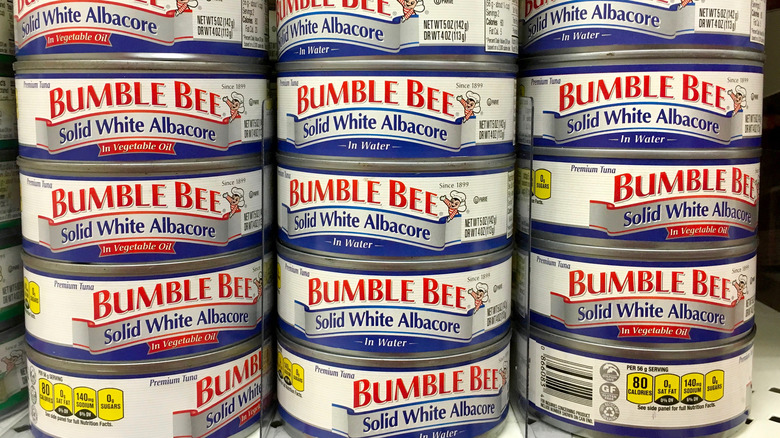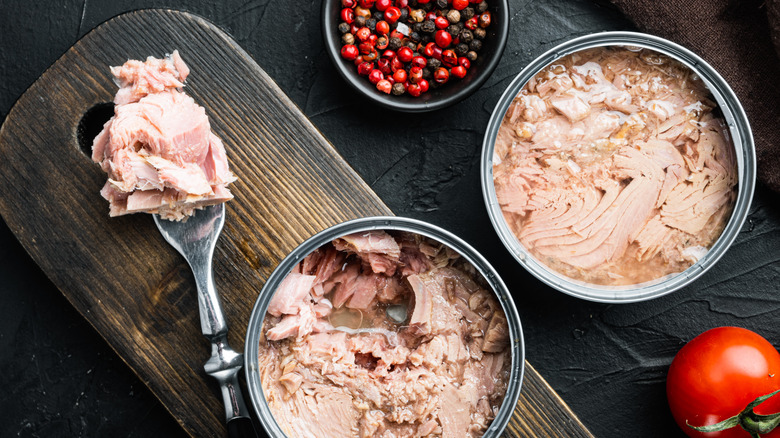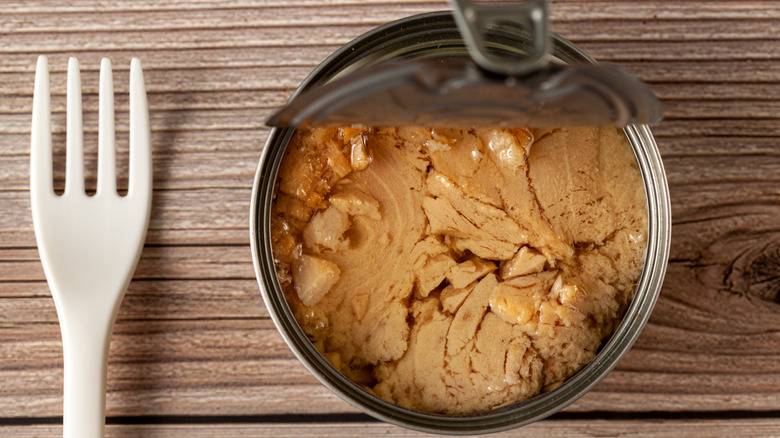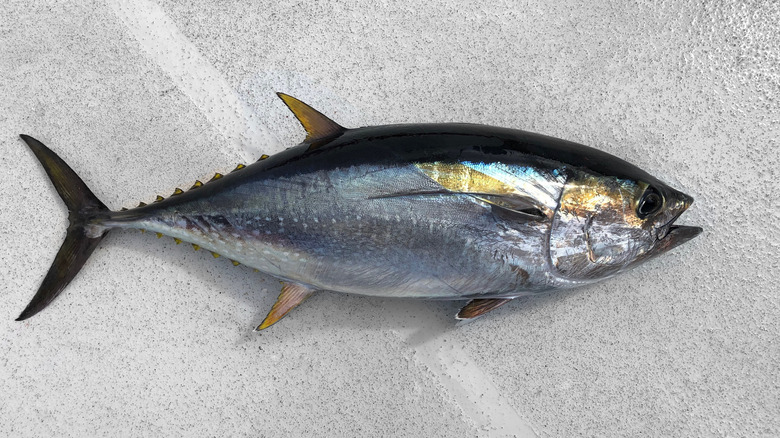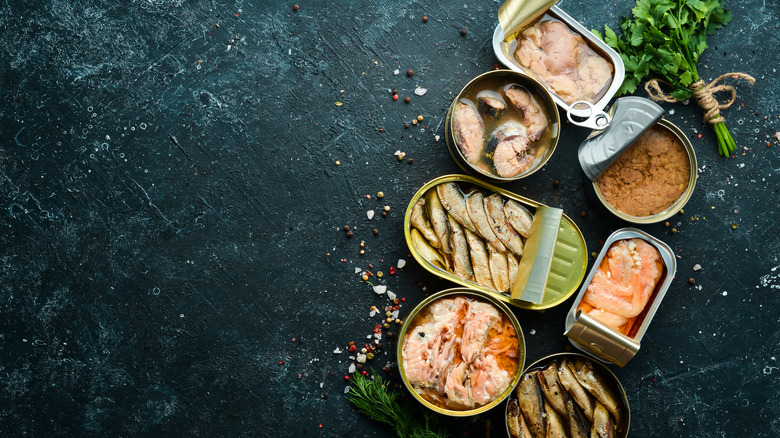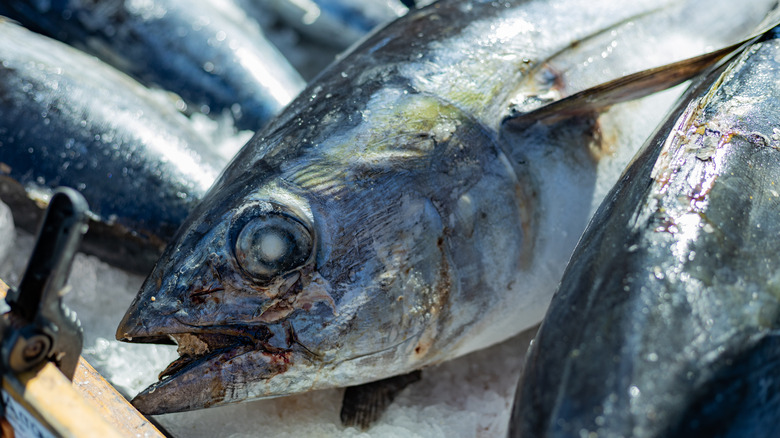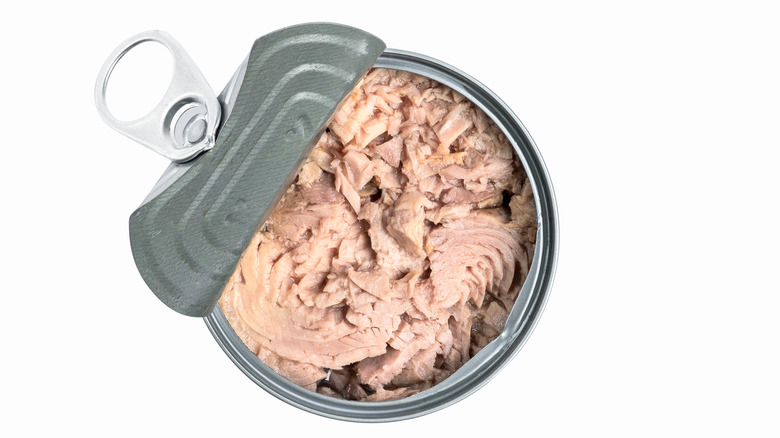Why You Should Always Read The Label On Canned Tuna
Canned tuna is a classic pantry staple that can make for a quick and easy meal any time of the day. Full of protein, vitamins, and healthy fats, canned tuna is shelf stable and has earned it a permanent spot in many American pantrys. According to a National Fisheries Institute survey, more than half of Americans keep some form of preserved tuna in their homes.
Canned tuna is safe to eat for up to four years as long as it is undamaged (via National Fisheries Institute). That means that when late-night cravings hit you can easily whip up a quick tuna salad, or go gourmet, and turn it into a batch of delicious tuna croquettes. It can also get mixed up with other produce along with common spices and condiments found around the house to help clear out the refrigerator.
Canned tuna has some health pluses
In addition to being tasty, all of these aforementioned recipe options are fairly nutritious. According to Healthline, canned tuna has approximately six to eight grams of protein per ounce. It's also a great source of Omega-3 fatty acids, selenium, iodine, and vitamin D.
As great as canned tuna can be though, it does come with some drawbacks.
When buying canned tuna it's important to look at the label and make sure that it is made with a type of tuna that is known to contain less mercury.
What mercury poisoning will do
According to Healthline, mercury is a dangerous mineral that builds up in the fatty flesh of tuna because of its large size. Consuming too much mercury can lead to some health risks, such as impaired brain function, focus, and memory. These adverse effects will likely not be noticeable right away, as the mercury takes time to amass in your body — just like in tuna. In addition to affecting your brain, high levels of mercury have been tied to heart disease and an increase in heart attack risk.
Because of mercury levels, the outlet recommends not consuming tuna on a daily basis despite its health benefits. Mercury poisoning can also be extremely harmful to pregnant people and children.
Certain canned tuna contains higher levels of mercury
Eat This, Not That! notes that the mercury content in canned tuna does depend on the kind of tuna being consumed though. According to the Environmental Defense Fund, albacore tuna, which is most commonly labeled as white tuna, contains three times the amount of mercury as skipjack tuna. Skipjacks are advertised as light tuna and are a smaller variety of tuna. They often contain less mercury because of their size.
Registered dietician nutritionist Lauren Manaker, MS, RDN told Eat This, Not That! that canned tunas which name the kind of tuna they contain are your best bet to avoiding high levels of mercury. It allows you to avoid large tuna, like yellowfin or albacore, and stick to the smaller kinds that can be safely consumed more often.
Other canned fish to avoid regular consumption
While the allure of canned tuna — its health benefits, convenience, and shelf life — make it a great pantry contender, there are other canned fish options that too should be avoided on a daily basis due to mercury levels. As noted by Nutrition Advance, while albacore takes the top spot as far as mercury levels are concerned, other fish varieties such as canned anchovies, canned crab meat, canned herring, and canned kippers shouldn't be consumed more than three times a week. Once you move away from the canned variety and are browsing the fish counter, you should really avoid options including swordfish, shark, or king mackerel, as those fish options have some of the highest levels of mercury around (per WebMD).
If you really want to avoid mercury at all costs while still getting your weekly fix of seafood, WebMD noted that the fish varieties with the least amount of mercury include shrimp, catfish, pollock, and salmon. So if tuna isn't the taste of the sea you're in search of (or you're looking for other safe options), these are a good bet.
Environmental impact of canned tuna
In addition to mercury content, it's also important to consider the environmental impact of your canned tuna selection. According to the World Wildlife Fund, tuna is a fish that has grown in popularity in recent decades, causing certain species of tuna to be in danger of overfishing. Some tuna fishing methods are also harmful to other ocean wildlife as well. Bycatch, or unwanted animals caught in tuna fishing nets, can sometimes make up 28% of a catch, harming populations of species like dolphins and sea turtles that are being killed needlessly. Because of these issues, it's important to look for the type of tuna being purchased and how it was caught.
Seafood Watch also recommends avoiding any canned tuna that are caught using Fish Aggregating Devices (FADs), which are responsible for much of the industry's bycatch issues. Instead, it recommends looking for phrases like "pole-caught," "troll-caught," or "pole and line caught" on cans. These indicate the tuna was sustainably fished using methods less likely to harm other species.
Brands to look for when considering sustainability
The Monterey Bay Aquarium Seafood Watch recommends buying canned tuna from brands that are eco-certified by the Marine Stewardship Council, or that they rate as "green Best Choice" or "yellow Good Alternative." It recommends the brands American Tuna, Fishing Vessel St. Jude, Mind Fish Co., Ocean Naturals, Safe Catch, Wild Planet, and Whole Foods as good options.
Greenpeace also offers its own recommended brands and shopping methods, with many of those brands matching up with Monterey Bay Aquarium Seafood Watch's suggestions. In addition to confirming Wild Planet, Ocean Naturals, and American Tuna as good options, Greenpeace suggests specific types of tuna from grocery store brands, like Trader Joe's skipjack, Costco's Kirkland Signature skipjack, and Hy-Vee's Select Responsible Choice in either skipjack or albacore.
For the best canned tuna for your body and for the planet, look for a low mercury tuna that has been sustainably sourced using key phrases printed on the label.
